BeoCord V8900
The final development of the V8800 model.
The final development of the V8800 model.
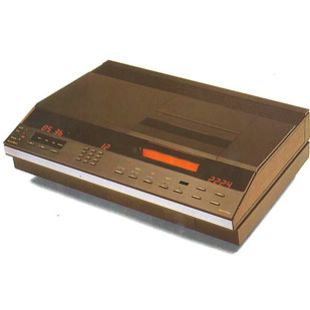
A further development of the Video 2000 video recorder.
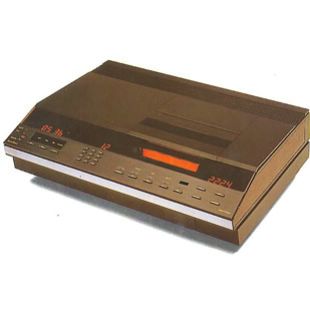
If your choice of TV viewing included video, the Beovision Video Terminal supplied with your Beovision 5100, 7100 or 8100 (or Beovision models 5500, 7700, 8800 and 9000 featured in the 1982 Autumn catalogue) could also be used to operate the Beocord V8802 video cassette recorder.
There were two types of video stand available, specially designed to accommodate any Bang & Olufsen VCR and combine them into a complete video system that was easy to install, easy to live with and a joy to use.
Beocord V8802 used the technical superiority of the V2000 format to guarantee top-quality recording and playback on economical flip-over cassettes. The 2×4 hour flip-over cassettes gave you 8 hours of recording time in one tape, which worked out cheaper in cost-per-minute terms than any other video format.
Microcomputer technology gave Beocord 8802-V a wide range of features and facilities and, at the same time, ensures that operation was fast, straightforward and fool-proof. Automatic track adjustment meant that even well-worn tapes recorded on another machine were reproduced accurately – that was important if you intended to hire feature film cassettes for home screening.
Sound quality was also of the highest quality with a technique called Dynamic Sound Suppression, reducing distortion and unwanted noise to negligible levels.
Freeze-frame and picture search are useful features, especially for sports fans, and both could be operated by remote control.
Another outstanding benefit was the ease with which Beocord’s computer-controlled timer could be programmed to make up to 5 automatic recordings from any 5 TV channels within a 16-day period. Of course, you could also record one programme while watching another. The Beovision Video Terminal kept you in control of the whole system without moving more than a finger.
The Terminal was supplied as part of the TV; if you purchased Beocord V8802 separately, or with a manual Beovision TV, the Terminal had to be purchased as an optional accessory in order for you to obtain the extra convenience of remotely controlled video.
Programming Beocord V8802 to make unattended recordings was quick and easy, thanks to logical control systems and microcomputers. Simply key in the channel, the day and the start and stop times of the programme you wanted recording. Each instruction was confirmed on the illuminated communications panel. The microcomputer’s memory could store 5 such sets of instructions covering the period of 16 days ahead. You could even check your programming for accuracy and correct mistakes by operating the ‘clear’ button. When all the programmed recordings had been completed the machine rewound the tape ready for instant replay.
The 8-hour flip-over cassette was more convenient and economical to use than any other type then on the market. The cassettes were tamper-proof: it was impossible to damage them by touching any moving parts or the tape itself. A safety switch built into the cassette casing prevented the inadvertent erasure of recordings you wanted to keep.
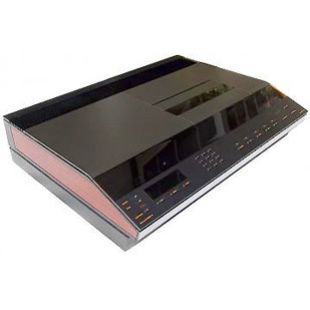
Beosystem 8800 Video was the only fully integrated home video system on the market in the early 1980’s. It comprised the Beocord 8800 video recorder, the Beovision 8800 colour TV, the Beovision Video Terminal and an elegant custom-built stand.
These individual components were designed to match and function harmoniously as one complete system, from a technical, functional, aesthetic and operational point of view. That is why you could operate all primary functions in the entire system from a distance using one infra-red remote control module. This gave you fast, easy, direct access to all facilities, whether these were ordinary TV programmes, recording or playback of video cassettes or Teletext home information services (when the Teletext circuitry is installed). Naturally, you could also make all important sound and video adjustments from the comfort of your chair.
The heart of Beocord 8800 Video was the 2 x 4-hour flip-over cassette – as part of the V2000 video system (similar to VHS and Betamax). It allowed you to make use of up to 8 hours recording time on one cassette, whereas most competing systems offered just 3,25 hours. Thus, the cassette was not only more convenient, it was also more economical to use than any other cassette on the market.
Another outstanding feature was that you could programme the Beocord to make 5 unattended recordings from 5 different TV channels at 5 different times up to 16 days in advance. You could have a relaxing holiday or travel on business, and be rest assured that you wouldn’t have to miss any of the programmes in your favourite TV series.
This creative use of machine intelligence (micro-computers) and the degree of flexibility and convenience afforded were unparalleled in competing video recorders. So too was the ease and speed with which you could operate the machine, thanks to its logical operation facilities and its large communication panel.
The optional stand for the Beosystem 8800 Video was both functional and attractive. It combined the TV receiver and recorder into one harmonious system, making the units even easier to install and convenient to live with at home. The positions of TV and VCR were reversible and the TV shelf had a rotating plate so you could alter its viewing angle at will. Beneath the shelf was a drawer for storing cassettes, headphones and other accessories. The stand was made of black anodised aluminium.
Programming the Beocord 8800 Video to make up to 5 unattended recordings during a 16-day period was both quick and easy, thanks to its logical operation facilities and microcomputers.
Illuminated symbols on the machine’s communication panel guided you through programming, step by step, confirming each step and keeping you informed at all times. You could even check your programming for accuracy and correct mistakes using the clear button. The 8-hour flip-over cassette allowed you to make high quality recordings at a lower cost per programme than ever before. The cassette had a tamper-proof design. Quite simply, it was impossible to damage it by accidentally touching the tape or any of its moving parts. A unique safety slider prevented you from inadvertently erasing a recorded cassette.
The Beovision Video Terminal was a remote control module which transmitted your instructions to the Beovision colour TV or the Beovision 8800 Video on a beam of infra-red light. It gave you immediate access to all primary functions on the Beosystem 8800 Video from anywhere in your room. You could select any of 16 TV channels on the Beovision. Or up to 26 if you made use of the Beocord’s TV tuning and storing facility. You could make video recordings or play a cassette. And if you had Teletext installed in your TV, you could operate this advanced home information service from a distance.
Naturally, you could also adjust volume levels, brilliance and colour without leaving your chair. Or mute the set but retain the picture, if the phone rang.
The Beovision Video Terminal was an integral part of Beovision 8800. Beocord 8800 Video could also be used with non-Bang & Olufsen TVs. If you chose to do so, you could still operate Beocord’s functions from a distance using the Beovision Video Terminal which was available separately (Type 3319).
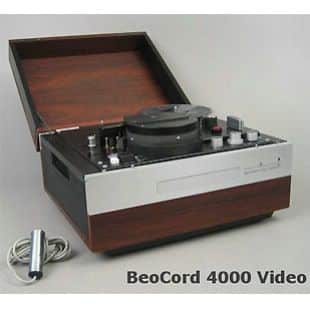
Beocord 4000 Video is shown here with Beovision 500 monitor (1969).
Video Camera 4000 could also be used with the video recorder, shown in the photo.
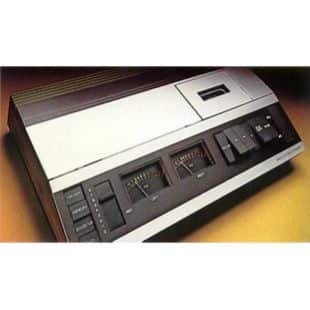
Beocord 1900 equalled Bang & Olufsen’s top-of-the-line cassette deck (Beocord 5000) in terms of specifications and performance, but it but it did not have the same wide range of facilities and operational refinements.
This does not mean that the Beocord 1900 was difficult to operate. On the contrary, the slanting front panel which contained all the operational facilities made the set’s controls handy and easily accessible. The cassette eject mechanism was air damped so that delivery was gentle and controlled. Two large VU meters enabled accurate setting of recording levels.
The microphones socket was placed discreetly under a sliding panel together with a balance control which enabled signal level adjustment in both channels. All the features which characterised high quality and high performance levels in cassette decks were incorporated. These included a combined recording/play-back Sendust tape head and Dolby B Noise Reduction circuits.
Beocord 1900 used precision techniques that ensured stable tape drive and the highest standards of recording and playback. Yet despite its comprehensive facilities it was easy to use and harmonised comfortably with many different Beosystems.
Beocord 1900 could be made up as part of the Beosystem 1900 or Beosystem2400, when linked together with other compatible Bang & Olufsen products.
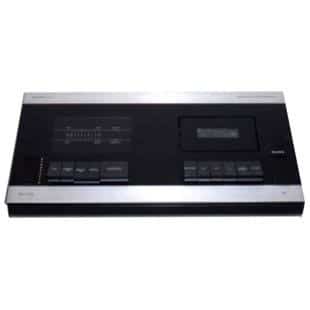
Beocord 1700 matched the Beomaster 1700 both physically and technically. It combined high performance with easy, straightforward operation.
Ferric, chrome or metal tapes could be used. The Sendust tape head, Dolby B circuits and Peak Programme Meter all contributed to high quality recording and playback. You could switch between all modes of play without fear of tangling the tape or damaging the mechanism.
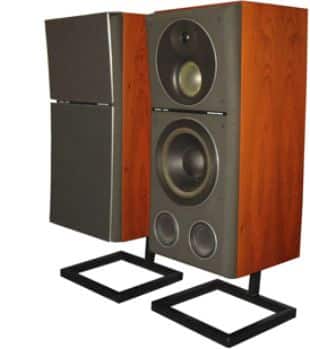
Beovox Uni-Phase MS150 and M150 were Bang & Olufsen’s answer to the need for loudspeakers that could cope with greater dynamic range and increased demand for serious, no-gimmick sound reproduction.
They were B&O’s biggest and most perfected loudspeakers up to the time of their introduction, designed to reproduce sound with a natural, linear phase quality – even at very high sound pressure levels. Their power handling capacities were specified at 150 watts RMS. However, effective overload protection circuits enabled them to handle brief passages of music way above their ratings.
Both speakers reproduced all types of music – from the faintest to the loudest notes – with extreme accuracy and precision, without adding to or subtracting from the signals they received.
In addition, the MS150 was designed to reproduce a clean, powerful bass in a relatively large room. That is why it was fitted with a monitor quality sub-woofer and had a net volume of 64 litres. It reproduced the lowest of tones that any record, tape or FM broadcast could deliver. Apart from the sub-woofer, all other speaker drivers in both models were identical.
Behind this successful design lay a new acoustic technology, an integrated loudspeaker design which put Bang & Olufsen in control of all the parameters that affected the loudspeakers’ performance. That is, all, except the room acoustics in which they were situated.
The new technology was based upon the use of Fourier analysis, computer-aided design and simulation techniques and laser holography. It helped prove measuring, calculating and testing techniques and thereby led to better cross-over filters’ design, refinement of patented linear phase techniques, control cabinet resonances and the minimisation of diffractions caused by the cabinet’s traditionally sharp-edged profiles. There was also a redesigning of the necessary drivers in order to meet precise construction requirements and perform optimally.
A monitor quality sub-woofer, a 20cm bass unit and a 64 litre net cabinet secured clean, powerful, bass reproduction. The mid-range unit, a 7,5cm dome tweeter, was aperiodically tuned to secure the exact frequency response characteristic required, while the super tweeter ensured excellent high frequency response.
Beovox M150-2 featured a 3-unit configuration to ensure monitor-quality sound reproduction in the 38 – 22000 Hz frequency range. Power handling capacity was 150 watts RMS with overload protection on all drive units. The 7,5cm unit acted as a mid-range filler-driver to eliminate audible phase distortion, so the music was always crisp and well defined with individual instruments correctly ‘positioned’ in the musical landscape. Pedestals were included as standard equipment.

Beovox Uni-Phase MS150 and M150 were Bang & Olufsen’s answer to the need for loudspeakers that could cope with greater dynamic range and increased demand for serious, no-gimmick sound reproduction.
They were B&O’s biggest and most perfected loudspeakers up to the time of their introduction, designed to reproduce sound with a natural, linear phase quality – even at very high sound pressure levels. Their power handling capacities were specified at 150 watts RMS. However, effective overload protection circuits enabled them to handle brief passages of music way above their ratings.
Both speakers reproduced all types of music – from the faintest to the loudest notes – with extreme accuracy and precision, without adding to or subtracting from the signals they received.
In addition, the MS150 was designed to reproduce a clean, powerful bass in a relatively large room. That is why it was fitted with a monitor quality sub-woofer and had a net volume of 64 litres. It reproduced the lowest of tones that any record, tape or FM broadcast could deliver. Apart from the sub-woofer, all other speaker drivers in both models were identical.
Behind this successful design lay a new acoustic technology, an integrated loudspeaker design which put Bang & Olufsen in control of all the parameters that affected the loudspeakers’ performance. That is, all, except the room acoustics in which they were situated.
The new technology was based upon the use of Fourier analysis, computer-aided design and simulation techniques and laser holography. It helped prove measuring, calculating and testing techniques and thereby led to better cross-over filters’ design, refinement of patented linear phase techniques, control cabinet resonances and the minimisation of diffractions caused by the cabinet’s traditionally sharp-edged profiles. There was also a redesigning of the necessary drivers in order to meet precise construction requirements and perform optimally.
A monitor quality sub-woofer, a 20cm bass unit and a 64 litre net cabinet secured clean, powerful, bass reproduction. The mid-range unit, a 7,5cm dome tweeter, was aperiodically tuned to secure the exact frequency response characteristic required, while the super tweeter ensured excellent high frequency response.
Beovox M150-2 featured a 3-unit configuration to ensure monitor-quality sound reproduction in the 38 – 22000 Hz frequency range. Power handling capacity was 150 watts RMS with overload protection on all drive units. The 7,5cm unit acted as a mid-range filler-driver to eliminate audible phase distortion, so the music was always crisp and well defined with individual instruments correctly ‘positioned’ in the musical landscape. Pedestals were included as standard equipment.
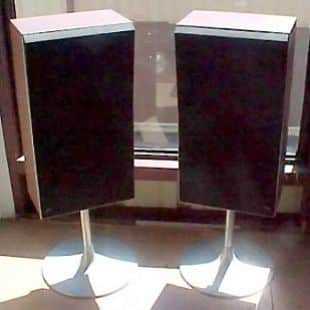
Top of the range monitor speaker, these were much more like the Beovox S60 than the Beovox M75 that replaced them.
They were 4 way speakers with the tweeter and midrange level with each other and the Phase link and woofer below. They could be fitted with the dramatic trumpet stand and were the speakers specified for the Beosystem 6000.